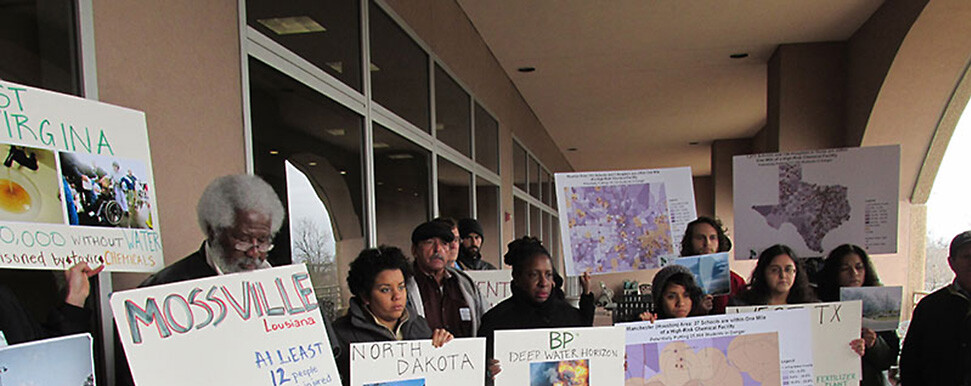
Media
July 22, 2013Residents of Contaminated Community to be Relocated Away from Toxic Chemicals Exposure; Many residents have died and are sick from chemical plant exposures
Contact: Stephenie Hendricks, (415) 258-9151, shendricks@comingcleaninc.org
(Mossville, LA) The people of Mossville, Louisiana, living in the shadow of chronic toxic chemicals exposure from 14 petrochemical facilities, will have the opportunity to voluntarily relocate, according to a statement announced Friday by the South African-based energy and chemicals company, Sasol. Mossville is an historic African American community located in southwest Louisiana.
“A Sasol representative announced plans to introduce the Voluntary Property Purchase Program in Mossville,” says Mossville resident Dorothy Felix, with Mossville Environmental Action Now (MEAN). “We have been advocating for relocation for years and know that the only way the plan can work is to meet the needs of Mossville residents, who suffer from industrial pollution that make us sick and ruin the value of our homes.”
“Our prior work on a successful community relocation offer between the Diamond community of Norco and the Shell Corporation in 2000 provides important lessons on how a community and an industrial company can reach agreement on future industrial operations, the terms for relocation offers, and programs for community improvements,” explains Monique Harden, Esq., attorney with Advocates for Environmental Human Rights, which represents Mossville residents and MEAN in a case before the Inter-American Commission on Human Rights that charges the U.S. Government with violating human rights by permitting toxic industrial releases in and around Mossville.
“While we have been clear that many Mossville residents, renters and owners, want to relocate to protect their health, it is important to understand what is motivating Sasol,” said Felix.
In December 2012, Sasol announced that it would begin engineering and design work for a world-scale ethane cracker and a plant that converts natural gas from shale rock into diesel fuel, known as a “gas-to-liquids” or GTL facility. Sasol plans to build and operate the industrial facilities on a site near Mossville that takes up three square miles. Sasol boasts that the “estimated cost is between $16 and $21 billion,” which represents “the largest single manufacturing investment in the history of Louisiana and one of the largest foreign direct investment manufacturing projects in U.S. history.” Sasol has not made public the estimated pollution increase and potential risk of a hazardous accident from the proposed ethane cracker and GTL facility.
A third party contractor, Community Interaction Consulting, Inc. (CIC), will administer the Program, opening an office in the community in early August and they say they will launch a website to provide Program specifics, timelines and contact information. Sasol has said that CIC will host small group information sessions at the Program office for prospective participants around mid-August.
“Environmental health and environmental justice groups from all over the United States and the world are watching what happens in Mossville,” declares Michele Roberts, with Environmental Health and Justice Alliance for Chemical Policy Reform, “And we will stand by the people of Mossville until they are safely out of harms way from toxic chemical contamination. At this moment in time, Louisiana Senator David Vitter has proposed a bill for reforming federal chemical regulations that ignores “hot spots” or “sacrifice zones” like Mossville. We are demanding that Senator Vitter restore the “Hot Spot” provisions to the Chemical Safety Improvement Act to reform the Toxic Substance and Control Act of 1976 to truly protect communities such as Mossville from chemical hazard.”
Additional Resources
Report: Industrial Sources of Dioxin Poisoning in Mossville, LA
CNN Special: Toxic Towns: People of Mossville "Are like an experiment"
Environmental Justice and Health Alliance Statement on the Chemical Safety Improvement Act
Advocates for Environmental Human Rights
Available for Comment
Dorothy Felix; Mossville Environmental Action Now; (337) 882-8078, mossville4ej@yahoo.com. Dorothy can tell about how Senator Vitter’s own state of Louisiana has among the highest cancer rates in the nation from chemical exposures and unprotected communities.
Delma & Christine Bennett; Mossville Environmental Action Now; (337) 882-1439.
Monique Harden, Esq.; Co-Director and Attorney, Advocates for Environmental Human Rights; (504) 799-3060, mharden@ehumanrights.org. Monique is an attorney with expertise on human rights and environmental legislation and judicial decisions in the U.S. and abroad. Her organization’s litigation on behalf of African American residents of Mossville, LA has led to a precedent by the Inter-American Commission on Human Rights of the Organization of American States, which decided for the first time to take jurisdiction over a case of environmental racism in the United States.
Michele Roberts; Co-Coordinator, Environmental Justice Health Alliance for Chemical Policy Reform; (202) 704-7593, mroberts@comingcleaninc.org. Michele can discuss the disproportionate impacts from toxic chemicals on communities of color.
Michael Hayes; Sasol; (337) 494-5038, michael.hayes@us.sasol.com.
